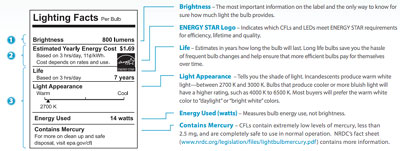This Saturday we change the clocks and prepare for shorter days. This gradual decrease in daylight is sometimes called the "lighting season" because more artificial light is needed in homes and businesses.
With greater use of lights comes increased energy consumption, which of course, can be minimized if you have switched out incandescent lights to more efficient fluorescents and LEDs.
It’s amazing how much impact efficient lighting makes – rarely, does such a simple move make such a difference.
Lighting accounts for about 19% of the power consumed in the US, and coincidentally, nuclear plants provide 19% of US electricity. Thus, one could argue that our fleet of 104 commercial reactors exists to keep the lights on.
There’s also a big impact on the need for coal. If every one of the 4 billion screw-based light bulb sockets in the US contained a compact fluorescent or LED, the US wouldn’t need 30 coal plants’ worth of power, calculates Natural Resources Defense Council (NRDC). Mercury emissions from power plants would drop 60% and 100 million tons of carbon would be prevented from entering the atmosphere each year.
The transition to more efficient lighting in the US has created over 1500 manufacturing jobs in Ohio as well as other states.
As part of the 2012 omnibus spending bill (which appropriate spending levels for agencies), Republicans managed to block funding for the Dept of Energy to enforce the new light bulb efficiency bill. They tried hard to block the move to more efficient light bulbs altogether, if you remember.
How to Choose Bulbs
NRDC released an updated Light Bulb Buying Guide to help people find the best options for light bulbs these days.
Three kinds of bulbs are available today: in addition to compact fluorescents and LEDs, there are new, improved incandescents, which are about 30% more efficient. As most of you know, CFLs and LEDs use 75% less energy than incandescents and last for 10-25 years.
A 60-watt LED costs about $10 today, down from $25-$40 just a couple of years ago.
It can be confusing to figure out which bulb will work in various sockets.
One idea is to bring your old bulb to the store and ask a clerk to help you find a replacement that delivers the same amount and type of light – and is roughly the same size to fit your existing fixture.
Rather than simply choosing a 60- or 100-watt bulb, it’s more important to evaluate these new bulbs based on how much light they produce (expressed in lumens) rather than how much power they use (watts).
The law requires this new label on light bulb packages:

LEDs, which are often dimmable, come in a variety of light colors. Select "warm white" if you want that yellowish white of the old incandescents and "daylight" if you want a cooler, more bluish hue.
The shape of a LED bulb also matters. Most LEDs now look more like the old incandescents and can distribute light in all directions. But those with a half dome on top don’t provide enough downward light so aren’t suitable for reading.

Make sure the label says it is Energy Star-certified.
Here is NRDC’s simple guide:

Ive been transition slowly since july 2012. Bulbs from G7POWER.COM, CREE AND walmart have helped. I like the 3000k temp of LED bulbs